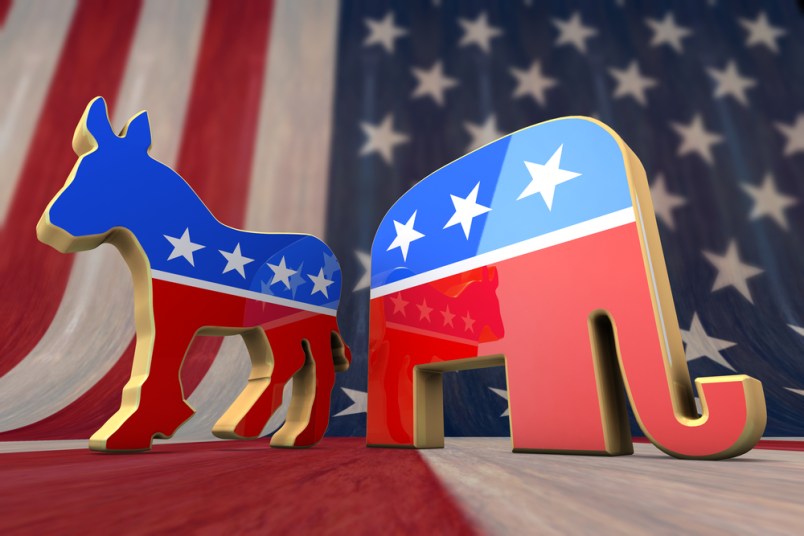It’s often instructive when serious political analysts — those not engaged in spin, or airy generalizations, or in the snail’s-eye search for “game change” events — have a serious difference of opinion. That’s how I’d characterize political scientist John Sides’ critique of his Washington Post colleague Dan Balz’s assessment of the positioning of the two major parties going into the 2016 presidential election cycle.
Balz focused usefully on the pattern of electoral votes secured by the two parties since 1992, along with demographic and political trends in certain battleground states, and concluded that Democrats approach 2016 with a much easier path to victory. He acknowledged Obama’s popularity would be a variable, along with the possibility that Republicans could finally find a way to reach out to Latinos, and didn’t make any predictions. But Balz provided some compelling data.
Sides, a well-known “fundamentalist” when it comes to analyzing presidential contests, touted a model he’s worked on that includes just three factors—presidential approval ratings, GDP growth and incumbency (or the lack thereof). He then suggested all the focus on “battleground states” and electoral vote tabulations obscures the power of the “fundamentals,” which show a much brighter picture for the GOP in 2016 than more granular approaches.
As a bit of a clincher, Sides offers this data point:
Since the passage of the 22nd amendment limiting the president to two terms, only one time (1980-88) has the incumbent party held the White House for more than two consecutive terms. The regularity with which control of the White House changes hands also suggests that the playing field may tip in the GOP’s favor in 2016.
Let’s look at this “third-term curse” (my term, not Sides’, though I suspect conservative media will be calling it that in 2016 previews) argument a bit more closely.
There have been six elections since the enactment of the 22nd Amendment where one party had held the White House the previous two terms (I’ll exclude 1952, because Democrats had controlled the White House for five previous terms, enough to induce party fatigue in any electorate). As Sides notes, the incumbent party won just one of these elections, in 1988. Five losses in six tries sounds pretty convincing as a trend, if not a “curse.” But then there’s 2000, when the incumbent party in fact won the popular vote and the electoral vote was contested. When it comes to Sides’ proposition that the “fundamentals” dictate a national trend more important than battleground state dynamics or electoral vote tabulations, 2000 has to count as an incumbent win. So now it’s four-out-of-six for the bums-get-thrown-out proposition.
That leaves four elections (1960, 1968, 1976 and 2008) as evidence for the “curse.” 1960, 1968 and 1976 were the three closest presidential elections (by popular vote) of the 20th century. All three were inarguably close enough that variable factors could have been and probably were decisive (namely: Kennedy’s religion, which attracted a lot more Catholics than it repelled Protestants, in 1960; the Democratic Party split and the assassination wave in 1968; and Watergate and Nixon’s forced resignation in 1976). Yes, the economy helped Democrats in 1960 and 1976, but in both cases it was tangibly improving by Election Day, and in any event, that doesn’t support the idea that sentiment to end the incumbent party’s control of the White House after two terms was an independent factor affecting the outcome.
To top it off, the two elections meeting Sides’ criteria that weren’t cliffhangers, 1988 and 2008, went in opposite directions, with the kind of demographic and battleground state factors Balz writes about representing a crucial difference.
This doesn’t prove Sides wrong and Balz right, of course, particularly since both of them were talking about influences on the outcome, and the 2016 general election is still 33 months away. But I’d recommend that Sides and anyone else looking ahead drop the “third-term curse” as a predictive factor. It represents a dubious lesson from a very small sample, and should henceforth be regarded mainly as spin.
Ed Kilgore is the principal blogger for Washington Monthly’s Political Animal blog, Managing Editor of The Democratic Strategist, and a Senior Fellow at theProgressive Policy Institute. Earlier he worked for three governors and a U.S. Senator. He can be followed on Twitter at @ed_kilgore.






